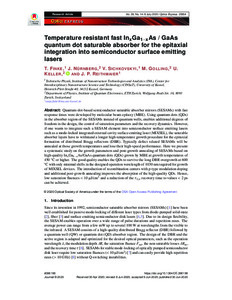Temperature resistant fast InxGa1−xAs / GaAs quantum dot saturable absorber for the epitaxial integration into semiconductor surface emitting lasers
| dc.date.accessioned | 2020-08-11T12:23:42Z | |
| dc.date.available | 2020-08-11T12:23:42Z | |
| dc.date.issued | 2020-06-30 | |
| dc.identifier | doi:10.17170/kobra-202008071543 | |
| dc.identifier.uri | http://hdl.handle.net/123456789/11678 | |
| dc.description.sponsorship | Gefördert durch den Publikationsfonds der Universität Kassel | ger |
| dc.language.iso | eng | eng |
| dc.rights | Urheberrechtlich geschützt | |
| dc.rights.uri | https://rightsstatements.org/page/InC/1.0/ | |
| dc.subject.ddc | 530 | |
| dc.title | Temperature resistant fast InxGa1−xAs / GaAs quantum dot saturable absorber for the epitaxial integration into semiconductor surface emitting lasers | eng |
| dc.type | Aufsatz | |
| dcterms.abstract | Quantum-dot-based semiconductor saturable absorber mirrors (SESAMs) with fast response times were developed by molecular beam epitaxy (MBE). Using quantum dots (QDs) in the absorber region of the SESAMs instead of quantum wells, enables additional degrees of freedom in the design, the control of saturation parameters and the recovery dynamics. However, if one wants to integrate such a SESAM element into semiconductor surface emitting lasers such as a mode-locked integrated external-cavity surface-emitting laser (MIXSEL), the saturable absorber layers have to withstand a longer high-temperature growth procedure for the epitaxial formation of distributed Bragg reflectors (DBR). Typically defect related SESAMs will be annealed at those growth temperatures and lose their high-speed performance. Here we present a systematic study on the growth parameters and post-growth annealing of SESAMs based on high-quality InxGa1−xAs/GaAs quantum dots (QDs) grown by MBE at growth temperatures of 450 °C or higher. The good quality enables the QDs to survive the long DBR overgrowth at 600 °C with only minimal shifts in the designed operation wavelength of 1030 nm required for growth of MIXSEL devices. The introduction of recombination centers with p-type modulation doping and additional post-growth annealing improves the absorption of the high-quality QDs. Hence, low saturation fluences < 10 µJ/cm2 and a reduction of the τ1/e recovery time to values < 2 ps can be achieved. | eng |
| dcterms.accessRights | open access | |
| dcterms.creator | Finke, Tanja | |
| dcterms.creator | Nürnberg, Jacob | |
| dcterms.creator | Sichkovskyi, Vitalii | |
| dcterms.creator | Golling, Matthias Christoph | |
| dcterms.creator | Keller, Ursula | |
| dcterms.creator | Reithmaier, Johann Peter | |
| dc.relation.doi | doi:10.1364/OE.396198 | |
| dc.subject.swd | Quantenpunkt | ger |
| dc.subject.swd | Sättigbare Absorption | ger |
| dc.subject.swd | Molekularstrahlepitaxie | ger |
| dc.type.version | publishedVersion | |
| dcterms.source.identifier | EISSN 1094-4087 | |
| dcterms.source.issue | Issue 14 | |
| dcterms.source.journal | Optics express | eng |
| dcterms.source.pageinfo | 20954-20966 | |
| dcterms.source.volume | Volume 28 | |
| kup.iskup | false |
Dateien zu dieser Ressource
Das Dokument erscheint in:
-
Artikel [1103]

